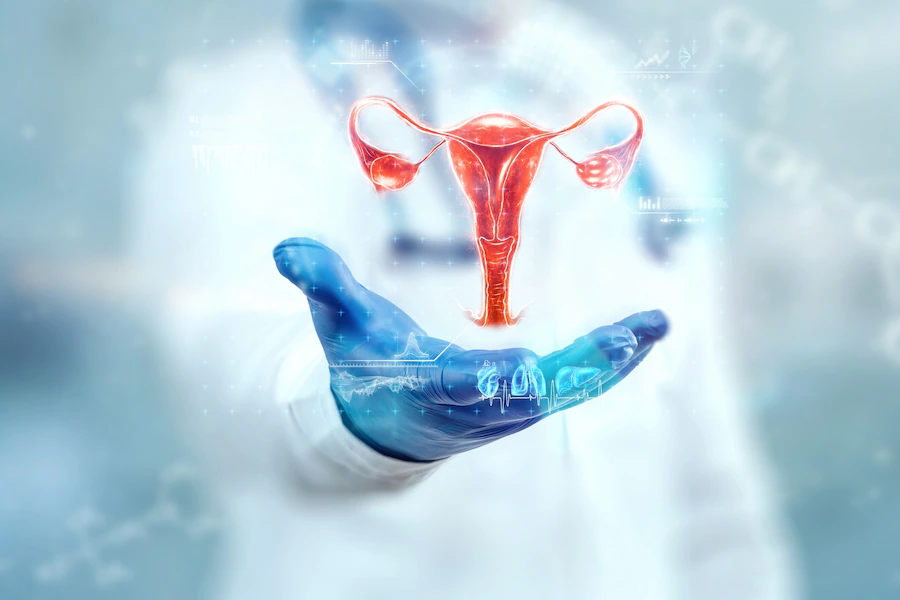- +91 914 521 2212
- enileshlomte@gmail.com
- +91 865 222 5725
- Aurangabad
OPD Timing:- 10:00am To 3:00pm / 6:00pm To 8:00pm
4 th Saturday off / Every Sunday off
Lab :- 7.00 am to 9.00 pm
Polycystic Ovaries, also known as Polycystic Ovary Syndrome (PCOS), are a hormonal disorder that affects women. This condition causes high levels of androgen, a male hormone, to be produced in women, resulting in a variety of health issues related to menstruation and pregnancy.
The signs and symptoms of polycystic ovaries are usually different from patient to patient. The following are some of the most common symptoms experienced by a woman with polycystic ovary syndrome:
● Irregular Menstruation: Women with PCOS do not ovulate, which prevents the uterine lining from shedding monthly. As a result, the menstrual cycle becomes irregular.
● Irregular Menstruation: Due to the absence of a regular period, the uterine lining builds up for a long time. In comparison to normal bleeding, a woman takes a heavy time until it actually starts to shed.
● Acne: The skin becomes oilier than normal due to an excess of androgen. Acne develops on the face, upper back, and chest as a result of this.
● Weight Gain: Obesity is common in women with polycystic ovaries, with more than 70% of them being obese.
● Darkening of the Skin: Dark patches of skin may appear on the neck, groyne, and under the breasts in some cases.
● Headache: Hormonal imbalances can also cause headaches.
● Hair Growth: Excessive hair growth on the face and body is another symptom of polycystic ovaries. Hirsutism is another name for this condition.
● Baldness: Male pattern baldness is a possibility for some women with polycystic ovaries.
Hormonal changes cause emotional disturbances.
Though the exact cause of polycystic ovaries is unknown, certain factors are frequently linked to an increase in androgen production. The following are some of the variables that may play a role in PCOS:
● Insulin excess: Insulin is a hormone that aids the cells in converting sugar from food into energy or storing it in the form of glucose for later use. Insulin resistance occurs when the body’s cells cease to respond normally to it, resulting in elevated insulin and sugar levels. Excess insulin may increase androgen production, causing ovulation problems.
● Genes: Polycystic ovaries are caused by a combination of genes. A good contributing factor is having a family member who does not have diabetes.
● Inflammation: Polycystic ovaries patients typically have high levels of inflammation in their bodies, which is related to the body’s excess production of androgen hormone.
Polycystic ovaries are not only responsible for the symptoms listed above, but they can also lead to a variety of health problems. The following are a few of them:
● Infertility: Women with polycystic ovaries are unable to ovulate on a regular basis, preventing the production of eggs for fertilisation. This causes problems during pregnancy and, in many cases, infertility.
● Sleep Apnea: Obesity can cause sleep apnea, a condition in which repeated pauses in breathing occur during the night, interrupting sleep.
● Metabolic Syndrome: The majority of women with polycystic ovaries are overweight or obese. High blood pressure, blood sugar, LDL cholesterol, and low HDL cholesterol are all risks associated with this. All of these factors combine to form metabolic syndrome, which raises the risk of stroke, diabetes, and heart disease.
● Endometrial Cancer: Endometrial cancer is caused by a thickened uterine lining caused by irregular ovulation.
● Depression: Many women with polycystic ovaries suffer from depression as a result of hormonal changes and unwanted hair growth.
When a woman’s symptoms and complications from polycystic ovaries are identified, PCOS specialists in Aurangabad, Dr. Nilesh Lomte may suggest a series of diagnostic tests to confirm the presence of the hormonal disorder. The PCOS specialists in Aurangabad begin by asking about the patient’s symptoms before moving on to the pelvic exam. Dr. Nilesh Lomte who is the Best Endocrinologist in Aurangabad , checks for problems with the ovaries or any other part of the reproductive system during the pelvic exam. Blood tests and an ultrasound are also used in the diagnostic process. Blood tests are used to see if there are any abnormally high levels of male hormones. In addition, an ultrasound test is used to detect abnormal follicles and other uterine and ovarian complications.
Despite the fact that there is no cure for polycystic ovaries, physicians should prescribe medications to help manage the symptoms. Treatment for primary polycystic ovaries entails making healthy lifestyle changes as well as taking medications. The majority of the time, the treatment is tailored to the patient’s condition. Weight control, reducing blood glucose levels, avoiding fertility problems, inhibiting acne development, and restoring regular periods are all goals of polycystic ovary therapy. The patient is expected to attend regular appointments to monitor his or her progress during the treatment.
OPD Timing:-
10:00am To 3:00pm
6:00pm To 8:00pm
Lab :- 7.00 am to 9.00 pm
4 th Saturday off
Every Sunday off
First consultation fees 500 rs
follow up fees 400 rs